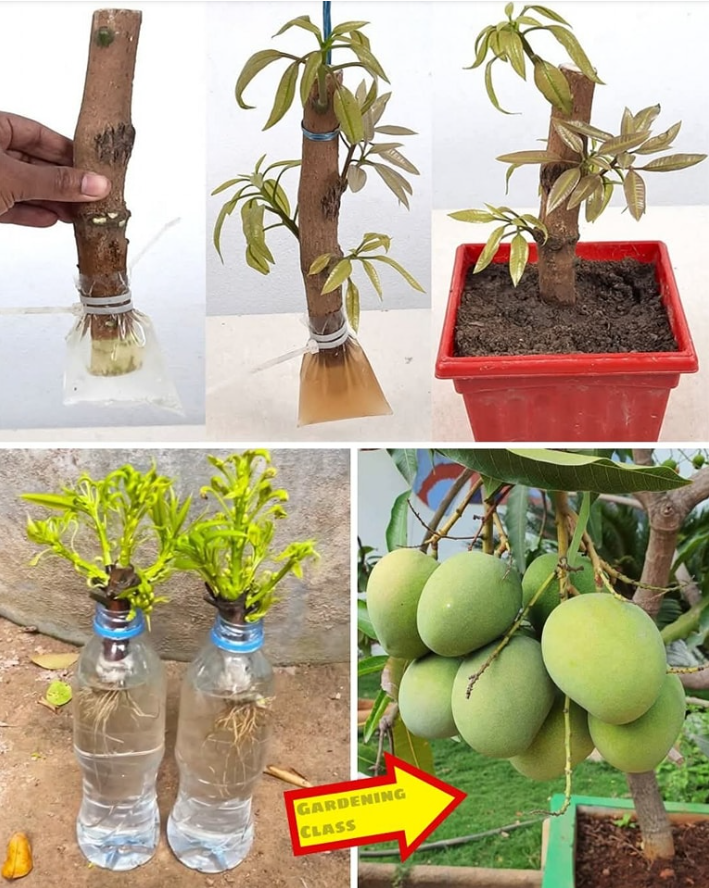Traditionally, mangoes are propagated through seeds or grafting, but those methods can take years or require advanced skills. Cuttings, on the other hand, offer benefits such as:
-
Genetic consistency: Unlike seed-grown trees, cuttings produce exact replicas of the parent tree.
-
Faster fruiting: Cutting-propagated mangoes can fruit sooner than seed-grown ones.
-
Space-saving: Perfect for container gardening or small spaces.
However, propagating mangoes from cuttings is challenging, so using proven techniques is essential.
What You’ll Need
-
A healthy mother mango tree
-
Sharp, sterile pruning shears
-
Rooting hormone (powder or gel)
-
Clean water
-
Potting mix (well-draining, like cocopeat and perlite or sand)
-
Small pots or containers
-
Clear plastic bags or a humidity dome
-
Spray bottle
-
Warm, shaded area
Step-by-Step: Propagating Mango from Cuttings
✅ Step 1: Select the Right Branch
Choose a semi-hardwood branch (not too young, not too old) — about 6 to 8 inches long, with a few healthy leaves.
Tip: The best time is late spring to early summer, when the plant is actively growing.
✅ Step 2: Prepare the Cutting
-
Remove any flower or fruit if present.
-
Cut just below a node (where a leaf attaches to the stem).
-
Remove the lower leaves, keeping 2–3 leaves at the top.
-
Optionally, scrape a bit of bark off the bottom inch to expose the cambium layer — this can enhance rooting.
✅ Step 3: Apply Rooting Hormone
Dip the cut end into rooting hormone to encourage faster and stronger root development. Shake off any excess.
✅ Step 4: Plant the Cutting
-
Fill a pot with moist, well-draining potting mix.
-
Stick the cutting 2–3 inches into the soil.
-
Gently firm the soil around it.
✅ Step 5: Create a Humid Environment
Cover the pot with a clear plastic bag or place it under a humidity dome. This maintains moisture and prevents the cutting from drying out.
Keep in a warm, shaded spot (not direct sunlight) with temperatures between 25–30°C (77–86°F).
✅ Step 6: Mist Daily and Wait
-
Mist the leaves once or twice a day.
-
Water the soil when it starts to dry (don’t overwater).
-
Roots may take 3–5 weeks to develop.
Unique Pro Tips for Better Success
-
Use air layering as a backup method: Wrap a node with moist sphagnum moss and plastic while still on the tree until roots form.
-
Add cinnamon powder to the cut as a natural antifungal and rooting booster.
-
Use a heat mat to maintain warm soil temperature, which mango cuttings love.
Transplanting the Rooted Cutting
Once your cutting has developed strong roots (at least 2–3 inches long), transplant it into a bigger pot with rich, loamy soil. Gradually expose it to sunlight over a week before moving it outdoors permanently.
Common Mistakes to Avoid
-
Using too young or too woody a branch
-
Overwatering or poor drainage
-
Not maintaining high humidity
-
Placing in full sun too soon
-
Skipping rooting hormone (greatly reduces chances)
Conclusion
While propagating mango trees from cuttings is not the easiest method, with the right technique, tools, and patience, it can be incredibly rewarding. Whether you’re expanding your tropical garden or experimenting as a plant enthusiast, these cutting-edge (literally!) propagation tips can help you grow a mango tree that’s productive, resilient, and truly your own.
